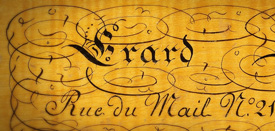
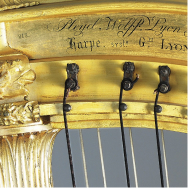
Archive Collection
Érard, Pleyel, Gaveau
Search Guide & Reading Support
In 2009, archives Érard, Pleyel and Gaveau were largely donated to the Museum of Music.
Finding an Instrument
You must orientate your search depending on information you hold on the instrument.
Depending on the document type, information can be organized by:
- 1. serial numbers
- 2. dates (sales, orders, repairs etc.)
Note: Only the Érard books of sales enable a search by name (buyer’s name index at the end).
You Know a Serial Number
Each instrument is assigned a unique serial number for identification. It is recorded in a specific workshop register, called "Manufacturing Register", at manufacturing stage or once the instrument is complete. Serial numbers are inscribed in ascending order and are only listed once; it is therefore easy to find the register for a given instrument.
Referring to a manufacturing register provides key information such as first sale’s date and buyer’s name. This information will prove useful when referring to other register types, such as books of sales.
Note: Between 1895 and 1937 Pleyel set up a double numbering system for pianos. Workshop registers from then work in pairs. Each of them mentions the two numbers but information is organized depending on one or the other. The first number is often called "Matricule de sortie" (release ID number) and the second "Matricule de fabrication" (manufacturing ID number). The Matricule de sortie” continues the preceding series of numbers. Instruments display both numbers - the "Matricule de fabrication" often including the letter "F" (e.g.: 3F456 for 3456). During a search, it is paramount to check the couple of numbers inscribed in the register match the relevant instrument.
Example of search by serial number
Knowing how to read an Érard Manufacturing Register
Knowing how to read a Pleyel Manufacturing Register
You Know a Date (purchase, repair etc.)
Each sale or order that took place in the shop is recorded in an account register (book of sales, order register etc.). Data is classified by chronological order.
Search Example
Finding information on Érard grand piano with serial number 13317
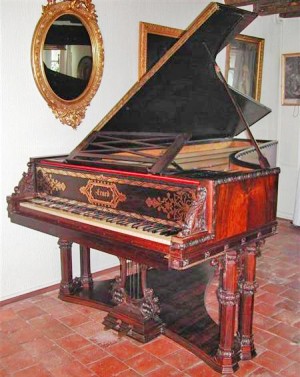
Grand Piano, Érard, serial number 13317
© Private Collection, P. Nguyen, France
I - Finding the Right Document
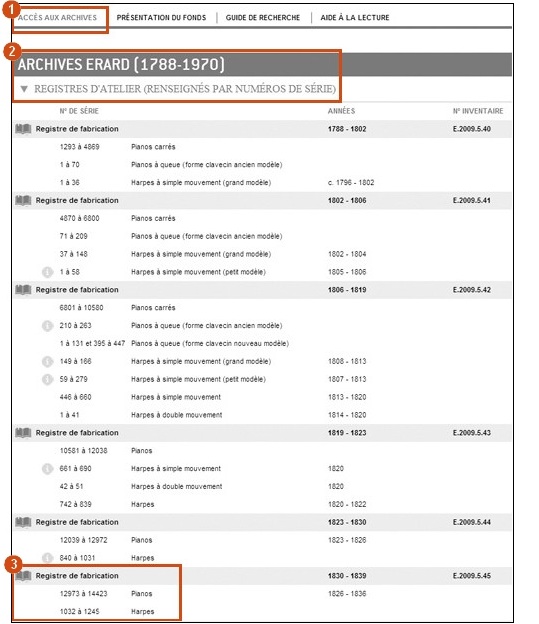
- 1 - Accessing digitized documents
-
Digitized documents are accessible on the "Accessing the Archives" page

- 2 - Choice of section
-
Known data are the instrument’s model (Érard) and serial number (13317). The search will therefore begin in the Érard archives and workshop registers, sole documents with serial numbers.

- 3 - Choice of document
-
To locate the right register, one only needs find the interval containing number 13317, then check it applies to the type of instrument sought. In the frame of this search, one must look in the manufacturing register concerning pianos 12973 to 14423..
Click on the document title to open it and display an overall view in a new tab.
II - Reading the Manufacturing Register
This manufacturing register includes information on pianos and harps. Once the piano section is identified one must go through serial numbers in ascending order, up to the required figure.

- 1- Ranking by serial numbers
-
Number 13317 is on page 32 of the visualization tool.

- 2- Instrument description
-
« forme de clavecin, en bois de palissandre, forme gothique»
"harpsichord shape, in rosewood, gothic shape"
In order to avoid any mistake, it is necessary to check the instrument described corresponds to the instrument sought.
- 3- Instrument construction date
-
« 31 mai 1834 »
"May 31st, 1834"
In this register, the "date d'entrée" indicates the end of the instrument manufacturing process.
- 4- Information on the instrument sale
-
« 14 mai 1835 - Mme la Princesse Begiojoso Place de la Madeleine - Liszt »
After leaving the factory this instrument was sold on 14th May 1835 to Mme la Princesse Belgiojoso, residing Place de la Madeleine. The sale was concluded through the intermediary of Mr Liszt.
Note: The sale date mentioned in the manufacturing register - 14th May, 1835 - gives access to the Érard account registers, classified by dates.

III - Finding Additional Information on the Instrument Sale
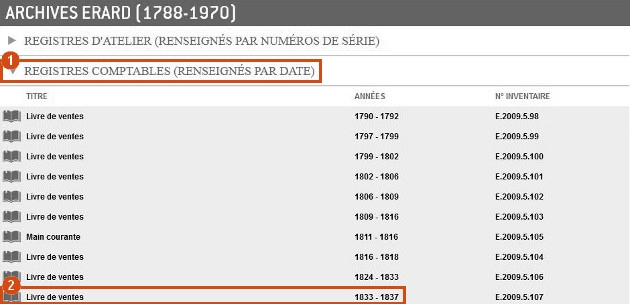
- 1- Accessing account registers
-
On the "accessing the archives" page, click on "account registers (search by date)"to display every register in this category.

- 2- Ranking by date
-
Only one register concerns year 1835. It is a sales book.

IV- Reading the Sales Book
Sales registers information is generally listed chronologically. In this precise case, a transaction in the name of Princess Belgiojoso was recorded on 14th May, 1835 (visualization tool, page 92).

- 1- Sale detail
-
The register records that piano number 13317 was bought on 14th May, 1835. It was in the shape of a gothic-style rosewood harpsichord, sold to Mme la Princesse Begiojoso, residing Place de la Madeleine, through the intermediary of Mr Liszt. The instrument was sold for 5,000 Francs and a commission of 1,000 Francs was granted Mr Liszt.
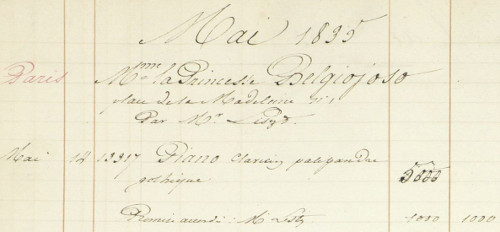
- 2- Conditions of payment
-
The register states that Princess Begiojoso paid for the instrument in cash on August 1st, 1835. Mr Liszt, for his part, received his commission in two installments.
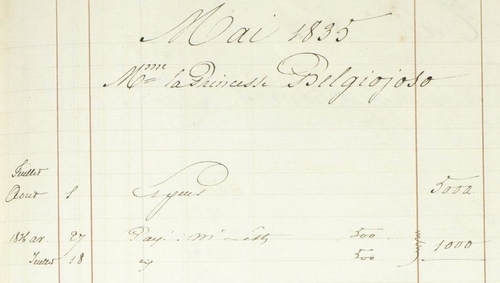
Érard: Manufacturing Registers
Manufacturing registers contain information on most Érard instruments, notably:
- serial numbers
- construction dates
- features (instrument type, wood used etc.)
- conditions of sale (purchase date, buyers’ name etc.)
Information is classified by serial number, in ascending order and mentioned only once to facilitate searching.
Note: From 1788 to 1823 Érard created a series of numbers for each instrument type (square piano, grand piano etc.). Registers reflect such serial number diversity, as they are divided into instrument sections. Sometimes these sections can overlap: it is therefore important to study the registers’ global structure properly before searching for information. After 1823, the firm simplified the system by using only two series of numbers: one for pianos and another for harps.
Érard Manufacturing Registers from 1788 to 1819The oldest Érard registers are very succinct.
1- Ranking by serial number
« 1619 »
2- Sale information
« Vendu à M. De Nanteuil »
"Sold to Mr De Nanteuil"
At the beginning of the 19th century, Érard registers set up the following general structure:
1- Workshop manager in charge of manufacturing
« Simon »
2- Instrument description
« 3c. 6 8ves à échapt »
3 strings per note, 6 octaves, escapement mechanism
3- Ranking by serial number:
« 12228 »
4- Sale information:
« 15 7bre 1890 - Mr Fetteau rue St Michel n° 5 à Bourges »
Sold on 15th September, 1890 to Mr Fetteau residing 5, rue Saint Michel, in Bourges
Pleyel: Manufacturing Registers
Manufacturing registers contain information on most instruments created by Pleyel, notably:
- serial numbers
- construction dates
- features (instrument type, wood used etc.)
- conditions of sale (purchase date, buyers’ name etc.)
Information is classified by serial number, in ascending order and mentioned only once to facilitate searching.
Note: From 1895 to 1937 Pleyel set up a double numbering system for pianos. During this period, each instrument had two serial numbers called “Matricule de sortie” (release ID number) and “Matricule de fabrication” (manufacturing ID number). Workshop registers from then work in pairs: both numbers appear on each of them but information is organized depending on one or the other. The first registers were listed by “Matricule de sortie”, the second ones by “Matricule de fabrication”. During a search, it is paramount to check the couple of numbers inscribed in the register match the relevant instrument.
Pleyel Manufacturing Registers from 1833 to 1937The first manufacturing registers detail the instruments’ construction stages.
1- Ranking by serial number
« 95851 »
2- Instrument description
« Queue p.p. 3bis Noir T »
"Grand piano, small template, model 3bis black, T."
3- Manufacturing stages description
People involved in the manufacturing chain are listed by name.
4- Information on instrument sale
« 8 décembre 88 – Foulet Frères & cie – Faub. Poissonnière – 1840 »
Piano sold on 8th December 1888 to Entreprise Foulet Frères et cie, located on Faubourg Poissonnière, at a price of 1,840 Francs.
In 1895, simplified registers succeeded to old manufacturing registers. The two coexisted together from 1985 to 1937 (piano double numbering period), then the old ones disappeared.
1- Ranking by serial number
« 127 401 - 15 F 362 »
This register mentions both serial numbers used by Pleyel between 1895 and 1937: "numéro de sortie" (release ID number) and "numéro de fabrication" (manufacturing ID number), but lists information by "numéro de sortie", i.e. the number in the first column.
2- Instrument description
« Droit 9 paliss. ver. nat. »
Upright piano, model 9, rosewood and natural varnish.
3- Sale information
« 27 mai 1902 – Harrods Stores –Londres – 750 »
Instrument sold on 27th May 1902 to Harrods in London at a price of 750 Francs.
Érard: Books of sales
Érard books of sales list every sale in the shop and include a buyers' index.
The registers’ structure did not evolve much over the years:
-
Sales, recorded chronologically, represent most of the register. They are usually listed across two pages: transaction details on the left (instrument sold, buyer’s name and address, discounts if applicable), payment information on the right.
-
A buyers’ index at the end of the register.
Note: Some professional clients have their own page in the register. It is frequently assigned to the first sale date and then used to record every transaction. Regular clients can only be located via the alphabetical index at the end.
Sales Detail1- Year and month of sale
« 1816, septembre »
" 1816, september "
2- Sale
Day of sale: « 5 »
Instrument serial number: « 9540 »
Sale detail:
« à 3c. 6 8ves à lyre à tambourin ornée, vendu à M. le Baron de Joinville du prix de 2 200, réduit à 2 100 par Catel,
remise au dit 300 f - 1800 »
Piano with three strings per note, decorated with a lyre, ornate timbrel, sold to Mr le Baron de Joinville at a price of 2,200 Francs, reduced to 2,100 Francs by Catel, discount to said [Catel] of 300 Francs, remains 1,800 Francs
3- Payment
Means of payment: « avoir par les mains de M. Catel qui a retenu sa remise en espèces »
"voucher from the hands of Mr Catel who kept his discount in cash"
Total sum paid by the buyer: « 1800 »
1- Buyer’s city of residence
« Bruxelles »
"Brussels"
2- Buyer’s name
« Rummel »
3- Folio numbers referencing the buyer
« 35. 12. 221 ; 250 ; 293 »
4- Alphabetical tab
« R »
Pleyel: Books of sales
Books of sales list commercial transactions from annual inventories carried out in the shop.
Sales books are divided in two parts. One lists new instruments; the other records second-hand instruments recovered by the shop, i.e. often exchanged by clients or bought second-hand. Each part is itself subdivided into years.
New instruments are ranked by serial number whereas recovered instruments are ranked by order of arrival. If an instrument in stock is not sold, it is re-listed in the inventory the following year.
Sales books describe each instrument and provide information on origin, sale or rental conditions, etc.
Note: Books of sales kept in the Museum of Music archive collection only concern the 1829-1858 period. One must refer to Pleyel manufacturing registers for commercial information outside of these dates..
New Instruments1- Ranked by serial number
« 3475 »
2- First part of the register dedicated to new instruments
« Inventaire des pianos en magasin le 1er juillet 1835, entrées et sorties »
"Piano inventory in shop on 1st July 1835, entries and exits"
3- Instrument description
« Carré – Acajou moiré – frises et filets – X – 3 – 2 – 6 ½ »
Square piano, in ornate iridescent mahogany, with x-shaped leg bases, three strings per note, 2 pedals and six and a half octaves.
4- Sale information
« Mme Vallon Blois – 7bre - 2000 »
Instrument sold in September to Mme Vallon, residing in Blois, at a price of 2,000 Francs.
1- Second part of the register dedicated to recovered instruments
« Pianos repris de divers, commencé le 1er avril 1834 »
"Pianos recovered from various people, begun on 1st April 1834"
2- Description de l’instrument
« 164 – Freudenthaler – 1815 – d° - 3 – 4 – 6 »
Piano carré n° 164 de la marque Freudenthaler, construit en 1815, comportant 3 cordes par notes, 4 pédales et 6 octaves.
À noter : « d° » signifie « ditto », c’est-à-dire « comme ci-dessus ». Dans ce contexte, cette expression renvoie donc à un piano carré.
3- Purchase information
« 1834 – 100 – avril – repris de M. Desvalières »
Instrument acheté à M. Desvalières pour 100 F en avril 1834
4- Resale information
« Mr Moussay – Paris – Mai - 120 »
Instrument resold in May to Mr Moussay, residing in Paris, at a price of 120 Francs.
Common Abbreviations
Registers contain many abbreviations. This page lists the most common ones.
Months of the Year
- Months of the Year
-
7bre : Septembre (sept-embre)
September -
8 bre : Octobre (octo [huit] bre)
October -
9 bre : Novembre (nov [neuf] bre)
November -
X bre : Décembre (dec [dix] embre)
December - Instrument Sizes
-
PP : Petit Patron
Small template -
GP : Grand Patron
Large template - Dito
-
d° : Ditto
Former past participle form of “to say” in Italian, signifying “as above”. -
Example of use:
This means instrument with serial number 4072 is also by Érard. - Octaves
-
8ves : Octaves
-
Example of use:
This describes a piano with 6 octaves.

